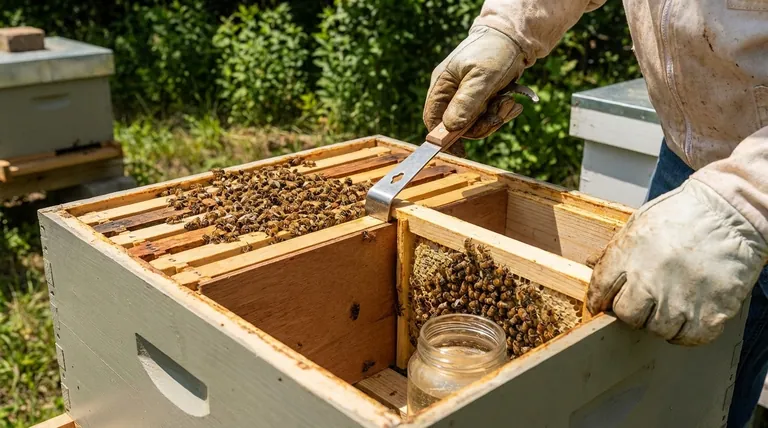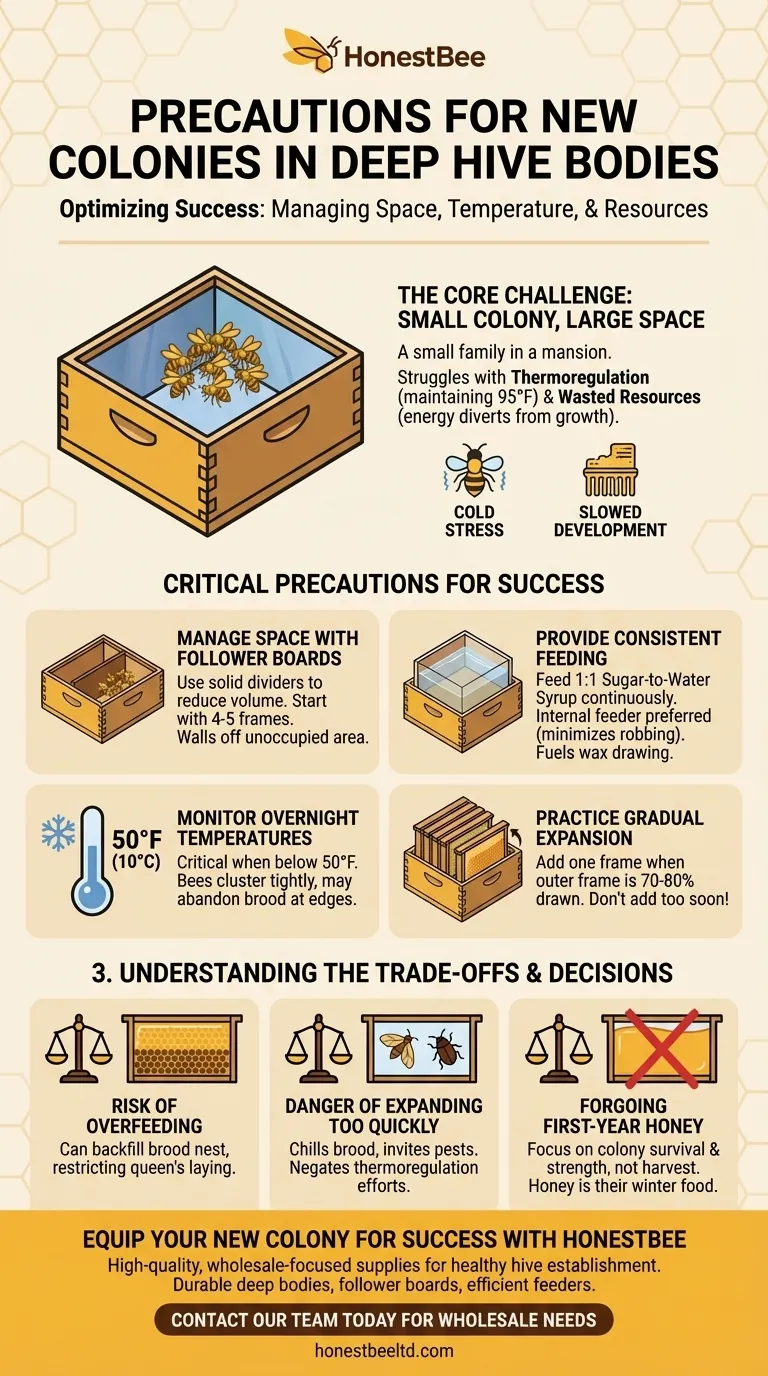The primary precautions for a new colony in a deep hive body are to manage the internal space, monitor temperature, and provide a consistent food source. Because a small cluster of bees cannot easily heat the large, vacant area of a full deep box, you must artificially reduce the hive volume and supply sugar syrup to fuel their critical initial tasks of drawing comb and raising brood.
A deep hive body is an excellent long-term home for a colony, but it is too large for them at the start. Your primary job is to make this large house feel small, warm, and well-stocked until the colony is strong enough to manage it on its own.

The Core Challenge: A Small Colony in a Large Space
A new package or nucleus (nuc) of bees is a small family moving into a mansion. While the space offers room to grow, it presents immediate survival challenges that you must help them overcome.
The Problem of Thermoregulation
Bees must maintain a brood nest temperature of around 95°F (35°C), regardless of the outside air temperature. In a large, empty hive, this is an immense energy expenditure.
A small cluster of bees will struggle to heat the vast, unoccupied space. This diverts their energy away from more productive tasks.
The Problem of Wasted Resources
Energy spent heating empty space is energy not spent on drawing wax comb, foraging, or raising new bees. This can dramatically slow down or even stall a new colony's development.
A colony that is constantly fighting the cold is a colony that cannot build its population and resources efficiently.
Critical Precautions for Colony Success
Your strategy should be to provide insulation, food, and a managed environment that allows the colony to focus its energy on growth.
Manage Space with Follower Boards
Do not give a new colony all ten frames of a deep box at once. Instead, use follower boards—solid dividers that take the place of frames—to wall off the unoccupied section of the hive.
Start the colony with just four or five frames. Place the follower board directly beside the last frame, effectively reducing the internal volume the bees must keep warm.
Provide Consistent Feeding
A new colony has no stored food and must build all of its wax comb from scratch. Feed them a 1:1 sugar-to-water syrup continuously.
An internal feeder (such as a frame feeder or top feeder) is preferable to an entrance feeder, as it minimizes the risk of attracting robber bees from other hives.
Monitor Overnight Temperatures
Pay close attention to nighttime temperatures. If they are expected to drop below 50°F (10°C), the colony will be under significant thermal stress.
Under these conditions, the bees will cluster tightly for warmth. They may be forced to abandon and sacrifice eggs or larvae on the outer edges of the brood nest, slowing population growth.
Practice Gradual Expansion
Do not add new frames until the bees have substantially built out the existing ones. A good rule of thumb is to add one new frame when the outermost frame is 70-80% drawn with wax comb.
Place the new, empty frame between the outermost drawn frame and the next one in. This encourages the bees to expand onto it in a controlled manner. Continue this process until all ten frames are drawn.
Understanding the Trade-offs
While these precautions are vital, it's important to be aware of potential missteps. Good beekeeping is about balance.
The Risk of Overfeeding
While consistent feeding is crucial, it can sometimes lead to the bees backfilling the brood nest with sugar syrup.
This occurs when they store syrup in cells where the queen should be laying eggs, restricting her ability to grow the colony's population. If you see this, you may need to pause feeding for a few days to allow her to lay.
The Danger of Expanding Too Quickly
Giving the bees too much space too soon is a common and costly mistake. It negates all your efforts to help them thermoregulate.
An oversized, undefended space not only chills the brood but also becomes an open invitation for pests like wax moths and small hive beetles to establish themselves.
Forgoing a First-Year Honey Crop
Do not place a honey super on the hive until the deep brood box is at least 80% full of drawn comb, brood, and resources. For most new colonies, this means you should not expect to harvest honey in the first year.
Consider the colony's first-year honey production as their own essential winter food. Your goal is colony survival and strength, not a honey harvest.
Making the Right Choice for Your Colony
Your management decisions should always be based on the colony's actual state of development, not a predetermined schedule.
- If your primary focus is rapid, healthy establishment: Start with a reduced number of frames, feed consistently, and only add space when the bees have earned it by building out their current frames.
- If you live in an area with cold spring nights: Using follower boards to constrict the hive volume is non-negotiable. This is the single most important step for preventing chilled brood.
- If you are starting with a small nuc or package: Prioritize their resource-building over your desire for honey. Forgo a first-year harvest to ensure they have the strength and stores to survive their first winter.
By actively managing space and resources, you provide the support a new colony needs to mature into a thriving, productive hive.
Summary Table:
| Precaution | Key Action | Why It's Important |
|---|---|---|
| Manage Space | Use follower boards to reduce hive volume. | Prevents chilled brood, saves bee energy. |
| Provide Food | Supply continuous 1:1 sugar syrup. | Fuels wax drawing and brood rearing. |
| Monitor Temperature | Watch for nights below 50°F (10°C). | Protects the brood nest from thermal stress. |
| Expand Gradually | Add frames only when 70-80% of comb is drawn. | Prevents overextension and pest issues. |
Equip your new colony for success with the right supplies from HONESTBEE.
Starting a new colony in a deep hive body requires precise management and reliable equipment. HONESTBEE supplies commercial apiaries and beekeeping equipment distributors with the high-quality, wholesale-focused supplies needed to support healthy hive establishment and growth—from durable deep hive bodies and follower boards to efficient feeders.
Let us help you build a stronger operation. Contact our team today to discuss your wholesale needs and how our equipment can contribute to the vitality of your bees.
Visual Guide

Related Products
- HONESTBEE Professional Multi-Functional Hive Tool with Ergonomic Wood Handle
- HONESTBEE Advanced Ergonomic Stainless Steel Hive Tool for Beekeeping
- Langstroth Bee Hives Bee Keeping Box for Beginners Beekeeping
- HONESTBEE Professional Long Handled Hive Tool with Precision Cutting Blade
- Professional Dual-End Stainless Steel Hive Tool for Beekeeping
People Also Ask
- What tools are useful when transferring frames from a nucleus hive? Ensure a Smooth and Low-Stress Move
- What types of hive tools are available for beekeepers? Choose the Right Lever for Your Apiary
- Why do hive tools have a hole? Unlock the Secret to Efficient Beekeeping
- What is a multifunction scraper hive tool? The All-in-One Solution for Efficient Beekeeping
- Why is it recommended to have multiple hive tools on hand? Essential Tips for Efficient Beekeeping



















